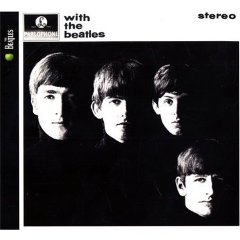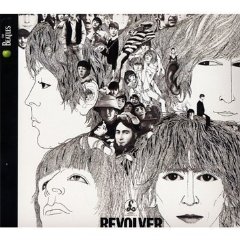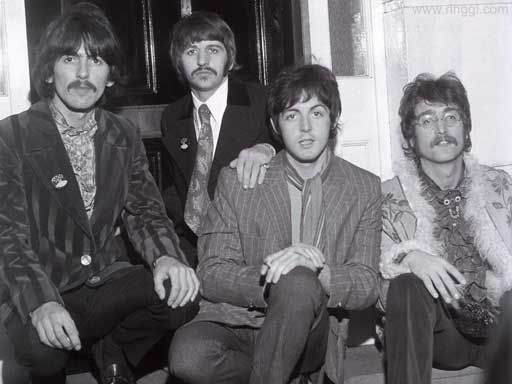The Beatles: Just as scriptures are richest when read metaphorically, so too with the Beatles.Gilding the Lilly
By Christopher Hill
With the Beatles (Remastered)
The Beatles
EMI
Revolver (Remastered)
The Beatles
EMIAs with every mystery, literal and metaphorical camps battle over the interpretation of the Beatles. The literalists want there to be a literal, comprehensible, even if awful, solution to the mystery of the Beatles. The search for the pseudonymous bootleg, the lost killer outtake, the “Carnival of Light,” the Masked Marauders, the clues to the death of Paul, even, down at the abyssal end of the chain, the Manson family’s Helter-Skelter delirium—these are all at one end or the other of the literalist quest.
But just as scriptures are richest when read metaphorically, so too with the Beatles.
Don’t look outside the work for miraculous validation, says the metaphorical view. Look deeper into it. The miracles are buried layer on layer in the work. Understand the puzzling, suggestive, evocative elements not as mysteries with a literal solution like a detective story, but metaphors designed to produce, as Owen Barfield said about poetry, “a felt change of consciousness.”
With its implied suggestion of a definitive revelation, of long-buried gold coming to the surface, the remastered Beatles catalog released this fall is in one sense a classic literalist project. The CDs come with a lot of fanfare and some inevitably excited expectations. “You’re going to be knocked…out,” my CD-store guy—normally cool as a cucumber in the face of hype—breathlessly assured me.
To get a manageable handle on the remastered catalog, I’ve taken two albums, one from the early ‘60s beginnings—With the Beatles—and one late ‘60s high point—Revolver. I then picked a “good part” from each song—a hook, a chorus, a riff, a bass line, a drum fill, a noise, a shout, the bits of gratuitous inspiration that great performances throw off. At these isolated high water marks, I’ve compared the remastered version with the previous CD version. Here are the results.
The Beatles, ‘Don’t Bother Me,’ from With The Beatles
Track: With the Beatles “It Won’t Be Long”
Impatient, undeniable, “It Won’t Be long”—apparently already in full cry when the track begins—bursts out with everything that initially caught people’s attention about the band– melody and power churning in tandem, as if they were the most natural comrades in the world; and that something odd that cropped up in most early Beatles songs, something hard to put a finger on, especially hard for dowdy post-war England of 1962. In this case it was …
The good part: The call and response. You know—“It won’t be long yeah- yeah, yeah-yeah, yeah-yeah.” John for once on the prosaic side in the foreground with a simple colloquial “yeah”; Paul, responding from some place far off, is a wailing African ghost chasing after his partner.
Difference between remastered and previous version: None detectable.
Track: With the Beatles “Don’t Bother Me”
A dark rumba in the electric surf; where on earth did they pick up this rhythm and become so fluent at it?
The good part: The whole track, but in particular whatever hollow wooden thing it is that Ringo’s tapping on throughout.
Difference between remastered and original version: This track is louder than the original. It sounds—and this is true of almost all the remastered tracks—like the levels have been pushed across the board. Which is a bit of a disappointment since this is a trick—it’s what engineers do when there’s not that much new information buried in the track but they need a quick and obvious way to make it sound different.Track: With the Beatles “Little Child”
This good-humored come-on sounds like a throwaway at first, but, as Ian MacDonald pointed out, here is something like the authentic sexual argot of the Liverpool street. There’s sweat and smoke and stale beer and quick sex, but at the same time there’s a promise (that the whole world eventually bought) that if you came with them, there was a totally new kind good time to be had.Difference between remastered and original version: There’s a metallic echo on John’s vocal that we haven’t heard before, but I don’t know if it’s worth isolating him over in the right channel. This is a hallmark of these mixes—they take vocal tracks, which were placed centrally in the first stereo mixes, and assign them to a left or right channel.
Track: With the Beatles “Please Mr. Postman”
One cookin’ slab of race and gender-envy, as the Beatles once again choose black female personae to enrich their sound and style.The good part: The hook—“Check it and see, one more time for me;” placing a marker down forever to show what white guys found so cool about rhythm and blues. John’s frenzy barely held in check by Motown formalism.
Difference between remastered and original version: None detectable.
Track: With the Beatles “Hold Me Tight”
Beatlemania; the archetypal early Beatles feat—how to make the music barrel and fly at the same time, like a freight train running three feet off the ground. In this merging of sweetness and power the little girls finally heard a band that understood just how to rock them all night long.The good part: Handclaps, the secret of the Beatles’ magic.
Difference between remastered and original version: None detectable.
Track: With the Beatles “You Really Got a Hold On Me” In which they go up against the best there was—Smokey Robinson and the Miracles, backed by the exquisite Motown session crew. What cheek. No single element—singer, rhythm section, studio—was as good as what Smokey and the Miracles had. It wasn’t even a major Miracles song—Smokey had this much soul to spare most days. John, on the contrary, had to put everything he had into it and he only succeeded by wrestling the song out of the soul arena into rock & roll. A key document in the dialectic of black and white popular music
The good part: John’s vocal. The groan at the center of it, as opposed to Smokey’s lighter touch, brings out the theme of erotic servitude more clearly than in the original
Difference between remastered and original version: None detectable.
Track: With the Beatles “Money”
A cover of Barrett Strong’s original. One of the early Beatles’ mightiest rockers. The velvet glove comes off and we hear something like what the patrons of the Indra Club must have heard, a band at the far edge of exhaustion, in a rage of speed and beer hour after hour, working to hype themselves and the audience into frenzyThe good part: Paul and George’s backup vocals. A trademark of the band, the Beatles’ backup vocals grew out of their early efforts to nail the American girl group sound. Sometimes they sound like R&B angels; here they are an infernal chorus of sassy little demons seconding every wicked emotion in John’s rant.
Difference between remastered and previous version: Noticeable. The remix breathes new life into the track, reassigning instrument positions around the stereo spectrum. You can hear the instruments locking together more clearly. There’s a rhythm chording going on underneath George’s lead that keeps this beast of a thresher rolling so inexorably.
Revolver
Of all the Beatles work, Revolver best makes the case for their big time artistic status. For one thing it is the fruition of what they and George Martin had been doing since their first recording session together—giving every element of the music, not just the vocals, a distinctive, dramatic voice. Case in point—Ringo’s drums have here become more than percussion—they’re sound effects, characters; they comment ironically on the song. On Revolver everything is mannered and a little mad; nothing is quite natural. What life for a pop princeling in London in 1966 must have been like.
Their most elegant and sophisticated record is their most London record; a great London document, snap shots of England’s last great age. Blackly elegant in their Saville Row suits, Lennon-McCartney joined a line of great London wits, dandies and boulevardiers.
This, one feels instinctively, is the Beatles; not the groggy dayglo bandsmen to come on the next album. Revolver is truer to their style and wit.
Track: Revolver “Taxman”
George counts off the record, writes and sings the opening track, which features:The good part: One of the definitive psychedelic guitar breaks; a jagged strip of torn metal carving out a new guitar sound within which succeeding generations of lead guitarists could find a place.
Difference between remastered and previous version Follows the remastered tendency to contain the elements in separate stereo channels where they once spread across the spectrum. Aficionados can appreciate the several parts being help up for inspection this way, but mono fanatics might miss the sound of that serrated metal threshing around down in the mix.
Track: Revolver “Here There and Everywhere”
Wherein the greatest power pop singer seeks to find out once and for all if he’s as good as Brian Wilson. It’s close, it’s close. May be Paul’s most purely lovely song, which is of course, saying something.The good part: Paul’s vocal of course.
Difference between remastered and previous version: Here the remastered version shows its stuff. Paul’s vocal has about half again the presence of the earlier cd version.
Track: Revolver “She Said, She Said”
The Beatles greatest track? An ascending scalar bass figure under John’s “When I was a boy” melodic arc is precisely what people mean when they talk about Paul’s ”melodic” bass lines. It’s not just melodic, it’s lyric. John thrashes and flounders spiritually while George builds Gothic architraves of guitar noise around him. What a crazy, fierce beast this band could be.The good part: It’s made of good parts.
Difference between remastered and previous version: Compared to Pepper’s, the elements of Revolver are cleanly etched and economically applied. The tendency of the remix is to accentuates that quality.
The track: Revolver “Good Day Sunshine“
The band at its most euphoric. As evocative of English summer as the Beach Boys are of American summer.The good part: George Martin’s larky piano break, part American barrelhouse, part English music hall; the piano is the seal on the album’s neo-Edwardian groove, with a jaunty sway like Bertie Wooster sauntering down Piccadilly.
Difference between remastered and previous version: On the older mixes, the piano is pushed about three quarters of the way down into the mix, so that it infuses the song from the bottom up with its gilded glow. The remastered version wisely leaves it there.
The track: Revolver “And Your Bird Can Sing”
This song, along with “She Said, She Said,” made two John contributions to the album where the impact depended crucially on summoning up guitar attacks without precedent in the Beatle’s career, if not in pop music. In both cases George’s response was inspired.The good part: The amazing Technicolor cascade of guitars, arguably George’s finest moment.
Difference between remastered and previous version: It’s hard to imagine how any revision would not be destructive.
The track: Revolver “Doctor Robert”
To jaunty Bakersfield-style guitars, John limns a sketch of a hip Dr. Feelgood bouncing around London distributing acid while wryly evoking august physicians of another era.The good part: The harmonium that gives the churchy drone to the “Well, well, well, you’re feeling fine…” chorus.
Difference between remastered and previous version: The harmonium stays just where they put it.
The track: Revolver “Got to Get You Into My Life”
Paul takes Bobby Darin out cruising the M4 in his XKE and all of a sudden the needle’s in the red zone and they’re swinging at a whole new level of intensity.The good part: Paul’s “Got to get you into my life!”, releasing the tension of this keyed-up, propulsive song. A great shout from a great shouter.
Difference between remastered and previous version: Paul’s as punchy as ever.
The Verdict: Real audiophiles with audiophile equipment and audiophile budgets will find interesting moments on most of the records in this series. But there are no secrets revealed here, no revelations, no grounds for re-assessment. Being charged with listening again carefully to these familiar records, what I mostly come away with is an appreciation for what a near-impeccable and frequently inspired job of recording George Martin and the band did. If this is the best shot that the Beatles establishment can take at shoring up weak spots or making up for shortcomings, the infrequency with which they’ve made any noticeable improvement is a powerful testament to George Martin’s vision for this band—and that in an era when rock and roll was not generally supposed to be substantial enough to carry the weight of vision.
Founder/Publisher/Editor: David McGee
Contributing Editors: Billy Altman, Laura Fissinger, Christopher Hill, Derk Richardson
Logo Design: John Mendelsohn (www.johnmendelsohn.com)
Website Design: Kieran McGee (www.kieranmcgee.com)
Staff Photographers: Audrey Harrod (Louisville, KY; www.flickr.com/audreyharrod), Alicia Zappier (New York)
E-mail: [email protected]
Mailing Address: David McGee, 201 W. 85 St.—5B, New York, NY 10024





